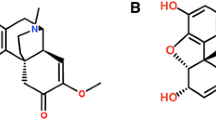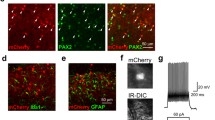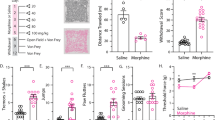Abstract
Although opioids still remain the most powerful pain-killers, the chronic use of opioid analgesics is largely limited by their numerous side-effects, including opioid dependence. However, the mechanism underlying this dependence is largely unknown. In this study, we used the withdrawal symptoms precipitated by naloxone to characterize opioid dependence in mice. We determined the functional role of mu-opioid receptors (MORs) expressed in different subpopulations of neurons in the development of morphine withdrawal. We found that conditional deletion of MORs from glutamatergic neurons expressing vesicular glutamate transporter 2 (Vglut2+) largely eliminated the naloxone-precipitated withdrawal symptoms. In contrast, conditional deletion of MORs expressed in GABAergic neurons had a limited effect on morphine withdrawal. Consistently, mice with MORs deleted from Vglut2+ glutamatergic neurons also showed no morphine-induced locomotor hyperactivity. Furthermore, morphine withdrawal and morphine-induced hyperactivity were not significantly affected by conditional knockout of MORs from dorsal spinal neurons. Taken together, our data indicate that the development of morphine withdrawal is largely mediated by MORs expressed in Vglut2+ glutamatergic neurons.





Similar content being viewed by others
References
Chen Y, Mestek A, Liu J, Hurley JA, Yu L. Molecular cloning and functional expression of a mu-opioid receptor from rat brain. Mol Pharmacol 1993, 44: 8–12.
Thompson RC, Mansour A, Akil H, Watson SJ. Cloning and pharmacological characterization of a rat mu opioid receptor. Neuron 1993, 11: 903–913.
Wang JB, Imai Y, Eppler CM, Gregor P, Spivak CE, Uhl GR. mu opiate receptor: cDNA cloning and expression. Proc Natl Acad Sci U S A 1993, 90: 10230–10234.
Matthes HW, Maldonado R, Simonin F, Valverde O, Slowe S, Kitchen I, et al. Loss of morphine-induced analgesia, reward effect and withdrawal symptoms in mice lacking the mu-opioid-receptor gene. Nature 1996, 383: 819–823.
Al-Hasani R, Bruchas MR. Molecular mechanisms of opioid receptor-dependent signaling and behavior. Anesthesiology 2011, 115: 1363–1381.
Stein C. Opioid receptors. Annu Rev Med 2016, 67: 433–451.
Corder G, Castro DC, Bruchas MR, Scherrer G. Endogenous and exogenous opioids in pain. Annu Rev Neurosci 2018, 41: 453–473.
Williams JT, Christie MJ, Manzoni O. Cellular and synaptic adaptations mediating opioid dependence. Physiol Rev 2001, 81: 299–343.
Burma NE, Kwok CH, Trang T. Therapies and mechanisms of opioid withdrawal. Pain Manag 2017, 7: 455–459.
Valentinova K, Tchenio A, Trusel M, Clerke JA, Lalive AL, Tzanoulinou S, et al. Morphine withdrawal recruits lateral habenula cytokine signaling to reduce synaptic excitation and sociability. Nat Neurosci 2019, 22: 1053–1056.
Maldonado R, Banos JE, Cabanero D. Usefulness of knockout mice to clarify the role of the opioid system in chronic pain. Br J Pharmacol 2018, 175: 2791–2808.
Weibel R, Reiss D, Karchewski L, Gardon O, Matifas A, Filliol D, et al. Mu opioid receptors on primary afferent nav1.8 neurons contribute to opiate-induced analgesia: insight from conditional knockout mice. PLoS One 2013, 8: e74706.
Corder G, Tawfik VL, Wang D, Sypek EI, Low SA, Dickinson JR, et al. Loss of mu opioid receptor signaling in nociceptors, but not microglia, abrogates morphine tolerance without disrupting analgesia. Nat Med 2017, 23: 164–173.
Fields HL, Margolis EB. Understanding opioid reward. Trends Neurosci 2015, 38: 217–225.
Charbogne P, Gardon O, Martin-Garcia E, Keyworth HL, Matsui A, Mechling AE, et al. Mu opioid receptors in gamma-aminobutyric acidergic forebrain neurons moderate motivation for heroin and palatable food. Biol Psychiatry 2017, 81: 778–788.
Ben Hamida S, Boulos LJ, McNicholas M, Charbogne P, Kieffer BL. Mu opioid receptors in GABAergic neurons of the forebrain promote alcohol reward and drinking. Addict Biol 2019, 24: 28–39.
Cui Y, Ostlund SB, James AS, Park CS, Ge W, Roberts KW, et al. Targeted expression of mu-opioid receptors in a subset of striatal direct-pathway neurons restores opiate reward. Nat Neurosci 2014, 17: 254–261.
Zhu Y, Wienecke CF, Nachtrab G, Chen X. A thalamic input to the nucleus accumbens mediates opiate dependence. Nature 2016, 530: 219–222.
Boulos LJ, Ben Hamida S, Bailly J, Maitra M, Ehrlich AT, Gaveriaux-Ruff C, et al. Mu opioid receptors in the medial habenula contribute to naloxone aversion. Neuropsychopharmacology 2020, 45: 247–255.
Wang D, Tawfik VL, Corder G, Low SA, Francois A, Basbaum AI, et al. Functional divergence of delta and mu opioid receptor organization in CNS pain circuits. Neuron 2018, 98: 90–108 e105.
Kline RHt, Wiley RG. Spinal mu-opioid receptor-expressing dorsal horn neurons: role in nociception and morphine antinociception. J Neurosci 2008, 28: 904–913.
Abbadie C, Lombard MC, Besson JM, Trafton JA, Basbaum AI. Mu and delta opioid receptor-like immunoreactivity in the cervical spinal cord of the rat after dorsal rhizotomy or neonatal capsaicin: an analysis of pre- and postsynaptic receptor distributions. Brain Res 2002, 930: 150–162.
Raghavendra V, Rutkowski MD, DeLeo JA. The role of spinal neuroimmune activation in morphine tolerance/hyperalgesia in neuropathic and sham-operated rats. J Neurosci 2002, 22: 9980–9989.
Song P, Zhao ZQ. The involvement of glial cells in the development of morphine tolerance. Neurosci Res 2001, 39: 281–286.
Mattioli TA, Leduc-Pessah H, Skelhorne-Gross G, Nicol CJ, Milne B, Trang T, et al. Toll-like receptor 4 mutant and null mice retain morphine-induced tolerance, hyperalgesia, and physical dependence. PLoS One 2014, 9: e97361.
Ferrini F, Trang T, Mattioli TA, Laffray S, Del’Guidice T, Lorenzo LE, et al. Morphine hyperalgesia gated through microglia-mediated disruption of neuronal Cl(-) homeostasis. Nat Neurosci 2013, 16: 183–192.
Drdla R, Gassner M, Gingl E, Sandkuhler J. Induction of synaptic long-term potentiation after opioid withdrawal. Science 2009, 325: 207–210.
Burma NE, Bonin RP, Leduc-Pessah H, Baimel C, Cairncross ZF, Mousseau M, et al. Blocking microglial pannexin-1 channels alleviates morphine withdrawal in rodents. Nat Med 2017, 23: 355–360.
Sieber MA, Storm R, Martinez-de-la-Torre M, Muller T, Wende H, Reuter K, et al. Lbx1 acts as a selector gene in the fate determination of somatosensory and viscerosensory relay neurons in the hindbrain. J Neurosci 2007, 27: 4902–4909.
Gao ZR, Chen WZ, Liu MZ, Chen XJ, Wan L, Zhang XY, et al. Tac1-expressing neurons in the periaqueductal gray facilitate the itch-scratching cycle via descending regulation. Neuron 2019, 101: 45–59 e49.
Lupp A, Richter N, Doll C, Nagel F, Schulz S. UMB-3, a novel rabbit monoclonal antibody, for assessing mu-opioid receptor expression in mouse, rat and human formalin-fixed and paraffin-embedded tissues. Regul Pept 2011, 167: 9–13.
Zhou W, Jin Y, Meng Q, Zhu X, Bai T, Tian Y, et al. A neural circuit for comorbid depressive symptoms in chronic pain. Nat Neurosci 2019, 22: 1649–1658.
Guo QH, Tong QH, Lu N, Cao H, Yang L, Zhang YQ. Proteomic analysis of the hippocampus in mouse models of trigeminal neuralgia and inescapable shock-induced depression. Neurosci Bull 2018, 34: 74–84.
Anthony TE, Dee N, Bernard A, Lerchner W, Heintz N, Anderson DJ. Control of stress-induced persistent anxiety by an extra-amygdala septohypothalamic circuit. Cell 2014, 156: 522–536.
Liu MY, Yin CY, Zhu LJ, Zhu XH, Xu C, Luo CX, et al. Sucrose preference test for measurement of stress-induced anhedonia in mice. Nat Protoc 2018, 13: 1686–1698.
Li Y, Liu J, Liu X, Su CJ, Zhang QL, Wang ZH, et al. Antidepressant-like action of single facial injection of botulinum neurotoxin A is associated with augmented 5-HT levels and BDNF/ERK/CREB pathways in mouse brain. Neurosci Bull 2019, 35: 661–672.
Lutz PE, Kieffer BL. Opioid receptors: distinct roles in mood disorders. Trends Neurosci 2013, 36: 195–206.
Trang T, Al-Hasani R, Salvemini D, Salter MW, Gutstein H, Cahill CM. Pain and poppies: the good, the bad, and the ugly of opioid analgesics. J Neurosci 2015, 35: 13879–13888.
Acknowledgements
We thank Yan-Jing Zhu for technical support. This work was supported by the National Natural Science Foundation of China (31825013 and 61890952) and the Strategic Priority Research Program of the Chinese Academy of Sciences (XDB32010200).
Author information
Authors and Affiliations
Corresponding author
Electronic supplementary material
Below is the link to the electronic supplementary material.
Rights and permissions
About this article
Cite this article
Zhang, XY., Li, Q., Dong, Y. et al. Mu-Opioid Receptors Expressed in Glutamatergic Neurons are Essential for Morphine Withdrawal. Neurosci. Bull. 36, 1095–1106 (2020). https://doi.org/10.1007/s12264-020-00515-5
Received:
Accepted:
Published:
Issue Date:
DOI: https://doi.org/10.1007/s12264-020-00515-5




